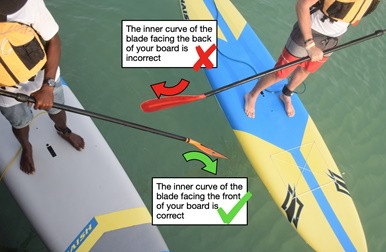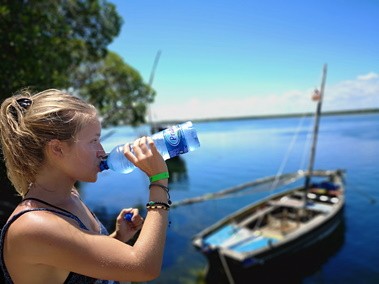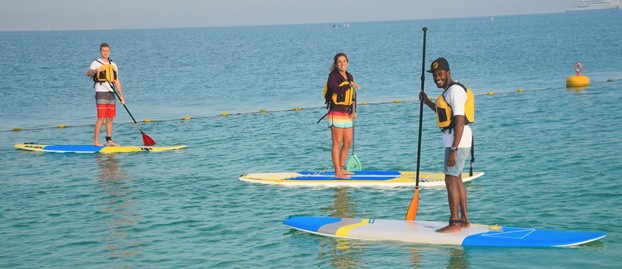PADDLE BOARDING: 10 COMMON MISTAKES THAT BEGINNERS USUALLY MAKE
If you are new to the paddle boarding scene, chances are you have been making some mistakes without realizing it.
Don’t worry. Everyone does, after all we are only human and beginners get extra leniency so in more than one way, being a newbie rocks!. Let’s take a look at some of the most common errors that, if we are being completely honest, every paddle boarder usually makes at one point or another.
Number 1: Paddle blade is facing the wrong way.
This is the most common mistake among paddle boarders, especially for beginners. When paddling, the correct way is to put the direction of the paddle blade bent away from you. This will allow you to speed up your paddling as well as provide good traction on the water. This way, you won’t waste much energy paddling on the water this as it’s much more efficient to paddle this way.
Number 2: Looking down at your board while paddling
This is one of the most common mistakes of many beginners; they stoop down while they paddle board. That’s a big mistake because this will cause you to lose your balance and fall off the board. A good technique when you paddle is to focus your eyesight on the horizon in front of you. Another option is to focus on something on the shore or in the water and you paddle yourself towards that object.
Number 3: Holding the paddle the wrong way
Some paddlers hold the paddle in the middle or with their hands too close to each other, though what they don’t know is that their grip is unstable when the paddle is held this way and very hard to paddle. Instead, the paddle should be held with one hand at the top and with one hand almost in the middle. Bear in mind however, that it depends on which side are you paddling. If you paddle on the right side of the board, it should be your left hand that is holding the top corner of your paddle. If you paddle on the left side, you do the opposite which is holding the top corner of the paddle using your right hand. The reason why you need to hold the paddle at the top is to give you a good grip as well as to help you gain more traction on the water every time you stroke your paddle.
Number 4: Not bringing water
Some paddle boarders (especially beginners) forget to bring water when they go out for a paddle boarding adventure. After all, it is easy to assume that this water sport is just a simple leisure activity and that it doesn’t need proper preparation to do it. You see, paddle boarding is in fact very good exercise. It’s an amazing full body workout that every health buff should try, but in order for you to stay energized, you have to keep yourself hydrated. That means drinking lots of water is a must when you go out on the water. A good healthy snack after your session is as important as drinking water. For sure, you’ll get hungry after a day’s workout with your paddle board.
Number 5: Standing on the wrong side of the board
Another common SUP mistakes that first-timers make is standing too far forward or backward on their board. The further you stand towards the nose of your board, the harder it will be to control your board and the further you stand backward more the nose of the board will go up and the easier you will lose your balance. Most paddleboards have a carry handle exactly at the center of the board. This carry handle can act as a reference for where you should stand on your board. Also another common mistake is standing the other way around on the board facing the back side of the paddle board!
Number 6: Not monitoring the weather
This is a really important thing that you need to do before you go out for a paddle boarding adventure. As we mentioned earlier, your safety must always be your utmost priority so be sure to always check the weather. The last thing that you want to experience is when you arrive at the location and be surprised that there is a storm waiting to ruin your day, or worse, having a storm arrive when you are already out there!
Number 7: Not using a leash
A paddle board leash is one of the most important pieces of gear that you need to put on when you go out paddle boarding; certainly, you don’t want to lose your paddle board in the water. On top of that, in case you accidentally fall into the water, the leash is there to keep you attached to your paddle board which ultimately serves to keep you safe as it means you won’t be stranded out in deep waters without a vessel to travel on. Your safety should be one of your primary concerns when you go out on the water so don’t forget to use a leash. At our paddle boarding shop located at Nessnass beach we do have a wide range of stand up paddle board leash of different length.
Number 8: Buying the wrong paddle board
When buying a paddle board there’s a few factors that we need to take into consideration, first of all the weight of the person using the paddle board, his/her level, where the paddle board is going to be used and what is it going to be used for (cruising, surfing, racing, etc…)
Based on the above details you can decide to go for a longer or shorter paddle board, a wider or narrower paddle board, a rigid paddle board or inflatable paddle board and how much volume.
Usually for beginners it’s recommended to go for a wider boards with bigger volume as it gives a lot of stability especially in the choppy conditions. For people looking for racing we recommend to go for longer and narrower paddle boards as this will allow them to go faster but please keep in mind this will make the board very unstable and not recommended for beginners or for someone who’s just getting into the sport
For sure another important factor in keep in mind is to go for an inflatable paddle board or a rigid paddle board based for sure on where you live an if you have a storage space for the rigid board.
You can visit our paddle boarding shop in Dubai to know more about the different type of paddle boards to choose from or you can check our collection available on our paddle board online shop
Number 9: Exposing your paddle board to direct sunlight for extended periods of time
If you want your board to last longer, you should refrain from keeping it under direct sunlight on land for a long period of time. Doing this will potentially damage the seams of your inflatable paddle board or delaminate your hard paddle board. The colors will also fade easily and it will affect the sturdiness of your board.
Number 10: Not inflating your board to the suggested PSI (Inflatable boards).
You want your Inflatable paddle board to perform at an optimum level. It won’t get to that point if you don’t follow the right PSI level – It will lose its toughness and performance. It’s highly advised that you should inflate your board to recommended Pressure suggested by the manufacturer and usually it’s written on the inflating valve of the board. This way, you’ll be guaranteed that you’ll get maximum performance and your paddle boarding experience will be with more time on the water than in the water.
FINAL THOUGHTS
Learning how to paddle board takes time to master, especially if you learn it on your own. Reading some blog posts and watching videos about paddle boarding may help you, but it will probably take some trial and error before you become confident at doing it yourself. If you want to fast-track the learning curve, Kite N Surf is there to help you improve your paddleboarding skills faster. In case you are planning to buy a paddle board we have a team of professionals who will guide through the buying process. You can reach out to us through email at [email protected] or call us at +971 55 800 6363.





